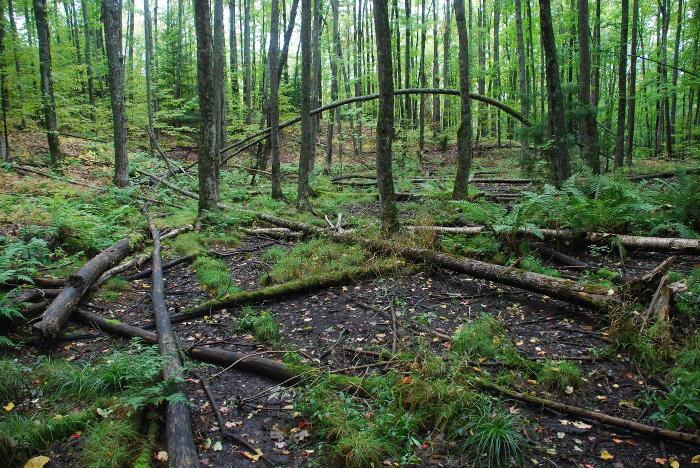Monday, Oct 9, 2023
Vernal pools are known well for their charismatic, burst-into-song come early spring. But as we enjoy our other beloved transition season of autumn, how do we identify quieter and drying vernal pools?
Vernal pools are often characterized by their variability, and can enter their dry phase in the summer and fall. Though easiest to spot when filled with water, here are some tips on how to identify a vernal pool in its dry phase without needing to enter the pool.
Zoom out
To recognize a vernal pool in its dry phase, it can be helpful to take a sort of “wide angle lens” approach. In comparison to a broader landscape perspective, dry vernal pools will look like a slight depression in the forest floor. While inundated or filled, vernal pools easily collect leaf litter, and as water levels drop, these leaves remain and will appear darkened, flat, and dull. This is a good indicator of a dry pool.
Look at the trees
Once you have identified a potential dry vernal pool, a good way to increase confidence is to examine the trees. Often, trees and shrubs growing in vernal pools will appear water-stained or darkened up to the point that they were underwater in the spring. In addition to this, seasonally-flooded trees may be exhibiting adaptations such as growing on raised mounds called hummocks, or have wide, external roots called buttressing.
Practice your plant ID skills
Plants growing in seasonally flooded areas will typically be wetland adapted plants that can survive in hydric, or very wet/saturated, soils. Pull out your plant identification guide or phone app to help you identify the trees and plants in the area. Plants that are obligate wetland (always occurring in wetlands) or facultative wetland (most often occurring in wetlands) species can help you confirm whether that area is seasonally flooded. In Michigan, some examples of these species are silver maple, eastern cottonwood, buttonbush, or tag alder.
Dig around in the dirt
Bring your spade out on your next hike. At a suspected vernal pool, shuffle through the leaf litter to look for fingernail clams! Dry vernal pools may have evidence of the past spring's macroinvertebrate diversity such as...
• Cases of caddisfly larvae (Trichoptera)
• Adults, juveniles, or shells of freshwater/fingernail clams (Pisidiidae), or airbreathing snails (Basommatophora)
• Shed skins or exuvia of dragonfly or damselfly larvae on edge of dry depression
So, while you are out enjoying the cooler weather, look out for drying vernal pools on your fall hikes. Share your fall vernal pool identifications or get help with your ID by posting in our Facebook community!

